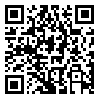Volume 12, Issue 2 (2024)
ECOPERSIA 2024, 12(2): 111-119 |
Back to browse issues page
Download citation:
BibTeX | RIS | EndNote | Medlars | ProCite | Reference Manager | RefWorks
Send citation to:



BibTeX | RIS | EndNote | Medlars | ProCite | Reference Manager | RefWorks
Send citation to:
Digra A, Kaushal A, Loshali D C. Evaluation of Multi-Sensor Satellite Data Accuracy for LU/LC Classification: Insights from Cartosat-1 and Liss-Iv Imagery In 2021. ECOPERSIA 2024; 12 (2) :111-119
URL: http://ecopersia.modares.ac.ir/article-24-66307-en.html
URL: http://ecopersia.modares.ac.ir/article-24-66307-en.html
1- Research Scientist, Department of Space, National Remote Sensing Centre, Indian Space Research Organisation, Regional Remote Sensing Centre, North, New Delhi-110049. , amritpaldigra30@gmail.com
2- Professor, Dept of Soil and Water Engineering, Punjab Agricultural University, Ludhiana, Punjab, India
3- Scientist SG, Punjab Remote Sensing Centre, Ludhiana, Punjab, India
2- Professor, Dept of Soil and Water Engineering, Punjab Agricultural University, Ludhiana, Punjab, India
3- Scientist SG, Punjab Remote Sensing Centre, Ludhiana, Punjab, India
Abstract: (1241 Views)
Aim: Due to increasing flaws in digital satellite images, the classification of land use and land cover (LU/LC) must be done accurately. It is important to assess the accuracy of Cartosat-1 and LISS-IV data, concentrating on how well-suited these data sets were for mapping and tracking land use and cover. The purpose of the study was to evaluate how well these datasets distinguished between various land cover categories.
Method: Supervised classification is crucial for accurate mapping and monitoring land cover and land use dynamics. It uses known samples to train classification algorithms, enabling detailed analysis and decision-making, and distinguishing subtle spectral variations. A total of 200 points were randomly selected in the study area using stratified random selection methodology for accuracy assessment which was verified using Google earth.
Findings: The results of study show that the overall accuracy for LU/LC classification of Cartosat-1 and LISS-IV for the year 2021 was obtained as 92% and 88.50% respectively with corresponding kappa coefficient values as 0.90 and 0.86 respectively which proves that data from Cartosat-1 is more accurate as compared to LISS-IV for LU/LC classification. It was also found that LU/LC classes belongs to both classified data of Cartosat-1 and LISS-IV data showed variability in their areas. Due to the high spatial resolution of Cartosat-1 data LULC classes edge to edge classification results have been obtained. Different feature have been purely identified and classified.
Conclusion: Cartosat-1 dataset is better than LISS-IV dataset for deailed LU/LC classification due to its high spatial resolution.
Method: Supervised classification is crucial for accurate mapping and monitoring land cover and land use dynamics. It uses known samples to train classification algorithms, enabling detailed analysis and decision-making, and distinguishing subtle spectral variations. A total of 200 points were randomly selected in the study area using stratified random selection methodology for accuracy assessment which was verified using Google earth.
Findings: The results of study show that the overall accuracy for LU/LC classification of Cartosat-1 and LISS-IV for the year 2021 was obtained as 92% and 88.50% respectively with corresponding kappa coefficient values as 0.90 and 0.86 respectively which proves that data from Cartosat-1 is more accurate as compared to LISS-IV for LU/LC classification. It was also found that LU/LC classes belongs to both classified data of Cartosat-1 and LISS-IV data showed variability in their areas. Due to the high spatial resolution of Cartosat-1 data LULC classes edge to edge classification results have been obtained. Different feature have been purely identified and classified.
Conclusion: Cartosat-1 dataset is better than LISS-IV dataset for deailed LU/LC classification due to its high spatial resolution.
Article Type: Original Research |
Subject:
Watershed Management
Received: 2022/12/24 | Revised: 2024/07/6 | Accepted: 2024/05/18 | Published: 2024/05/21
Received: 2022/12/24 | Revised: 2024/07/6 | Accepted: 2024/05/18 | Published: 2024/05/21
Send email to the article author
| Rights and permissions | |
 |
This work is licensed under a Creative Commons Attribution-NonCommercial 4.0 International License. |








